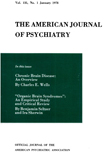The "relief effect": a sociobiological model for neurotic distress and large-group therapy
Abstract
The author discusses the new discipline of sociobiology. He develops the hypothesis that relief of neurotic distress may be associated with experiencing social affiliation and presents data that demonstrate a decline in neurotic symptom intensity in individuals who joined a cohesive religious sect. Anthropological and ethological evidence for the adaptive value of this "relief effect" provides a basis for the evolution of this trait. The author proposes a corresponding model for psychotherapy in large groups.
Access content
To read the fulltext, please use one of the options below to sign in or purchase access.- Personal login
- Institutional Login
- Sign in via OpenAthens
- Register for access
-
Please login/register if you wish to pair your device and check access availability.
Not a subscriber?
PsychiatryOnline subscription options offer access to the DSM-5 library, books, journals, CME, and patient resources. This all-in-one virtual library provides psychiatrists and mental health professionals with key resources for diagnosis, treatment, research, and professional development.
Need more help? PsychiatryOnline Customer Service may be reached by emailing [email protected] or by calling 800-368-5777 (in the U.S.) or 703-907-7322 (outside the U.S.).



